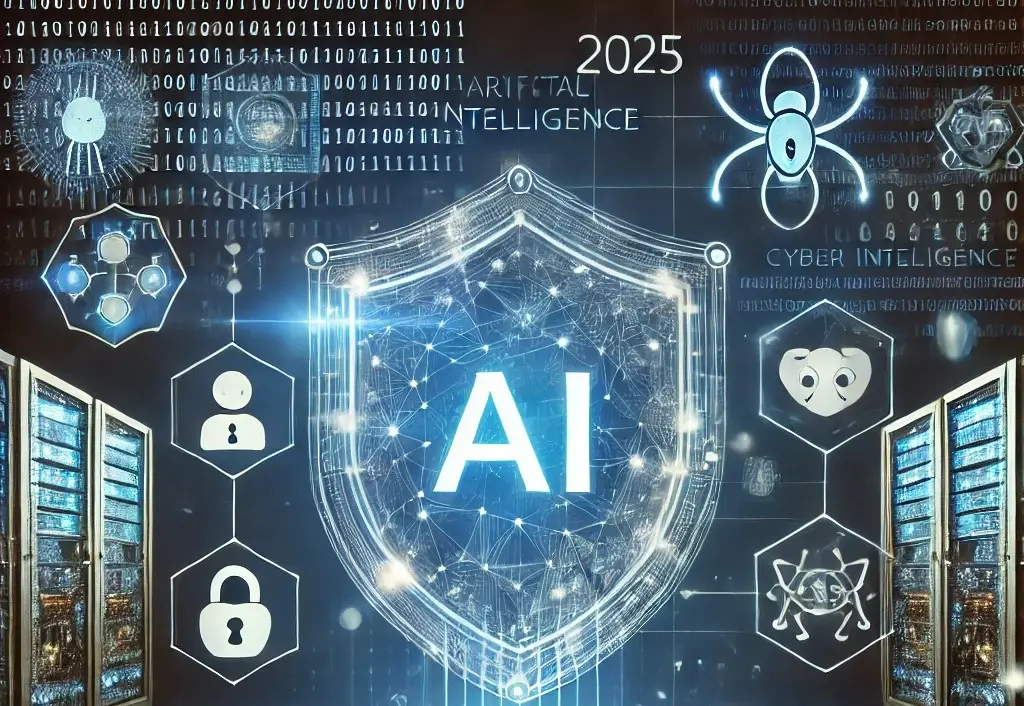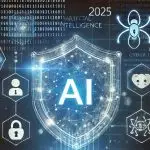In 2025, the integration of Artificial Intelligence (AI) into cybersecurity solutions has reached unprecedented levels, transforming the way organizations protect their digital assets. As cyber threats evolve in complexity, traditional approaches struggle to keep up, making AI a critical tool for staying ahead of adversaries. This article explores how AI is enhancing cybersecurity, the challenges it addresses, and its implications for the future.
The Growing Threat Landscape
Cyberattacks have become more sophisticated, targeting individuals, corporations, and even governments. Key trends in 2025 include:
- Ransomware-as-a-Service (RaaS): Cybercriminals now offer ransomware tools as subscription services, enabling less skilled hackers to execute attacks.
- Deepfake Threats: AI-generated deepfakes are being used for fraudulent activities, including impersonating executives and bypassing biometric security systems.
- IoT Vulnerabilities: With billions of IoT devices connected globally, the attack surface has expanded significantly.
- Supply Chain Attacks: Malicious actors increasingly target supply chains, exploiting weaker links to breach larger organizations.
AI is pivotal in mitigating these threats by providing advanced tools for detection, prevention, and response.
AI Applications in Cybersecurity
AI enhances cybersecurity through several innovative applications:
- Threat Detection and Prediction
- AI algorithms analyze massive datasets in real time to identify abnormal patterns indicative of threats.
- Machine learning (ML) models predict potential vulnerabilities and future attack vectors based on historical data.
- Advanced analytics use behavioral analysis to differentiate between normal and malicious activities.
- Automated Incident Response
- AI-powered tools automate responses to detected threats, minimizing human intervention and response time.
- Examples include isolating infected systems or blocking suspicious IP addresses immediately.
- Automated playbooks streamline responses to recurring threats, enhancing efficiency.
- Behavioral Analysis
- AI monitors user behavior to detect anomalies, such as unusual login locations or access to restricted files.
- This reduces the risk of insider threats and account takeovers.
- Continuous authentication using AI ensures that user sessions remain secure throughout access.
- Enhanced Endpoint Security
- AI secures devices by identifying and neutralizing malware, even those that use obfuscation techniques.
- Endpoint Detection and Response (EDR) solutions leverage AI to provide comprehensive protection.
- AI-driven antivirus programs adapt to new threats in real time, providing dynamic defenses.
- Fraud Detection
- AI systems identify fraudulent transactions by analyzing deviations from normal financial behaviors.
- Financial institutions utilize AI to detect and prevent scams and money laundering activities.
- AI models uncover hidden patterns in data that indicate fraud attempts before damage occurs.
- Phishing Prevention
- AI tools detect phishing emails and websites by analyzing content, links, and sender credibility.
- Real-time alerts help organizations educate employees and prevent breaches.
- AI-powered email filters reduce the chances of successful phishing attempts.
Real-World Examples
- Darktrace: A leading AI-driven cybersecurity company, Darktrace uses machine learning to detect and respond to threats autonomously, offering organizations 24/7 protection.
- CrowdStrike: This platform leverages AI to deliver endpoint protection, threat intelligence, and proactive attack prevention.
- IBM Watson for Cyber Security: By processing vast amounts of unstructured data, Watson assists security analysts in identifying and mitigating threats efficiently.
- FireEye: FireEye employs AI to deliver threat intelligence and advanced persistent threat (APT) detection, safeguarding critical infrastructure.
Advantages of AI in Cybersecurity
- Speed and Efficiency: AI can process and analyze data exponentially faster than human teams.
- Scalability: AI solutions can adapt to protect large networks with thousands of endpoints.
- Reduced Human Error: Automation minimizes the risks associated with manual oversight.
- Proactive Defense: Predictive analytics allow organizations to anticipate and address threats before they occur.
- Cost Efficiency: AI reduces the need for large cybersecurity teams, lowering overall operational costs.
- 24/7 Monitoring: AI tools work round-the-clock, providing continuous threat protection.
Challenges and Limitations
Despite its advantages, AI in cybersecurity faces several challenges:
- Adversarial AI: Cybercriminals are also leveraging AI to develop more sophisticated attacks.
- Examples include AI-generated malware that adapts to security measures.
- False Positives: Overzealous AI systems may generate excessive alerts, overwhelming security teams.
- Data Privacy Concerns: AI systems require large datasets, raising issues around the ethical use of sensitive information.
- High Implementation Costs: The initial investment in AI-powered solutions can be prohibitive for smaller organizations.
- Talent Gap: Skilled professionals are needed to design, implement, and manage AI systems, which can be challenging to recruit.
The Future of AI in Cybersecurity
Looking ahead, AI is expected to play an even more significant role in cybersecurity:
- Quantum-Resistant Solutions: As quantum computing evolves, AI will develop encryption techniques to counteract potential threats.
- Collaborative Defense Networks: AI will enable organizations to share threat intelligence securely and in real time.
- Adaptive Learning Models: AI systems will become more adept at learning from new threats and adapting defense mechanisms accordingly.
- Integration with Blockchain: AI and blockchain technologies will combine to enhance data integrity and transparency in cybersecurity solutions.
- Self-Healing Systems: Future AI models will empower systems to detect and repair vulnerabilities autonomously.
- Personalized Security Protocols: AI could tailor security protocols to individual users based on their behavior and needs.
- AI-Augmented Security Teams: Instead of replacing human teams, AI will serve as a powerful augmentation tool, handling repetitive tasks and providing insights that allow analysts to focus on strategic decisions.
Case Study: AI and Cybersecurity in Critical Infrastructure
Critical infrastructure, such as power grids, transportation systems, and healthcare networks, is increasingly targeted by cyberattacks. AI plays a crucial role in safeguarding these systems by:
- Real-Time Monitoring: AI-powered solutions provide 24/7 monitoring of critical systems, identifying and neutralizing threats before they escalate.
- Predictive Maintenance: AI can predict potential vulnerabilities in infrastructure components, enabling proactive maintenance and reducing downtime.
- Incident Simulation: AI enables organizations to simulate potential attack scenarios, helping them prepare robust defense strategies.
Tips for Businesses Adopting AI in Cybersecurity
- Start Small: Begin with specific AI-powered tools like threat detection or endpoint protection.
- Invest in Training: Ensure teams are trained to use and manage AI systems effectively.
- Choose Scalable Solutions: Select platforms that can grow with your organization’s needs.
- Monitor and Update: Regularly update AI models to keep up with evolving threats.
- Collaborate with Experts: Partner with cybersecurity professionals to implement robust AI strategies.
- Compliance: Ensure that AI tools comply with industry regulations and standards to avoid legal and operational risks.
AI is revolutionizing cybersecurity by enabling faster, smarter, and more proactive defenses against an ever-growing array of threats. While challenges remain, the benefits far outweigh the risks, making AI an indispensable asset in securing the digital landscape of 2025 and beyond. Organizations must embrace these advancements to stay resilient and maintain trust in an increasingly interconnected world.
By leveraging AI’s capabilities, businesses can not only protect their assets but also build a robust foundation for a secure and innovative future.










